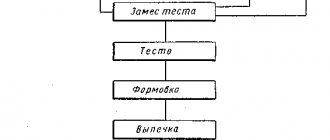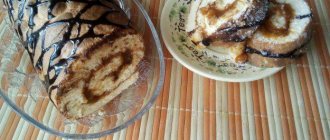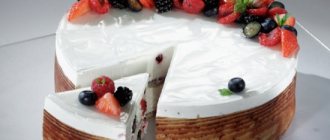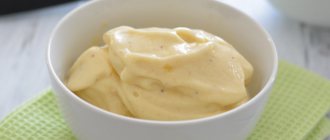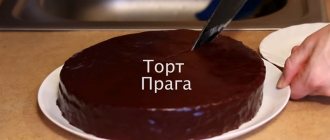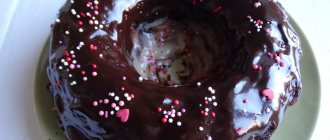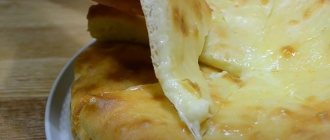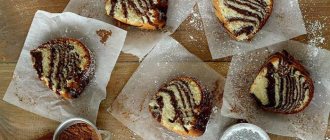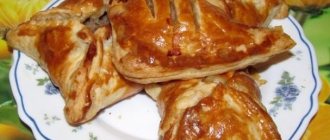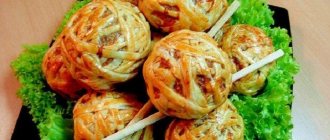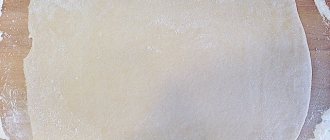Orange dessert
To create desserts you need to grind the leftover biscuit
. What you need:
- biscuit crumbs - 4 tbsp. l.;
- dried apricots - 1 handful;
- orange - 2 pcs.;
- cottage cheese (with a homogeneous consistency, you can use curd mass) – 150 g;
- sugar - 0.5 cups;
- cream liqueur - 4 tbsp. l.;
- water - 50–70 ml.
Cooking process:
- Soak the dried apricots in boiling water for 15 minutes until they become soft.
- Remove peels and membranes from oranges.
- Sprinkle these ingredients with half the sugar and grind everything in a blender.
- Place the resulting mixture in a small saucepan, place over low heat, and cook for 5 minutes.
- Dilute starch in water and add to fruit mixture. Cook for a few more minutes until the mixture thickens.
- Grind the cottage cheese with sugar, mix until smooth.
- Take 4 bowls, put 1 tbsp in each of them. l. biscuit crumbs, add 1 tbsp. l. liqueur, then oranges and dried apricots, the final layer is cottage cheese.
If desired, the dish is decorated with ground nuts, whipped cream, berries or grated chocolate.
LiveInternetLiveInternet
Quote from Vikylia24
Read in full In your quotation book or community!
Dishes made from biscuit dough.
Collection of the best recipes. Popular biscuit recipes
Curd sponge cake Fruit sponge cake Honey sponge cake Cheese sponge cake Coconut sponge cake Apple sponge cake Walnut-banana sponge cake Sour cream sponge cake Flourless hazelnut sponge cake Poppy sponge cake Savoy sponge cake Delicate orange sponge cake Chocolate sponge cake Almond sponge cake Boer sponge cake Cherry sponge cake C butter sponge cake
Sponge cakes
“Nezhenka” cake Sponge cake with curd cream Sponge cake with strawberries “Istra” cake Sponge cake with sour cream and fruit Sponge cake “Love for Three Oranges”
Sponge cake “Fruit Rainbow” Sponge cake “Universal” Sponge cake with kiwi Sponge cake “March Hare or Fluffy” Sponge cake with cream Sponge cake with jelly and fruit Chocolate cake with caramel cream Sponge cake “Blackberries with cream” Liqueur sponge cake Lemon sponge cake cake Sponge cake “Fairy Tale”
Pies made from sponge dough Quick apple pie Tyrolean pie Sponge pie with apples Sponge pie with raspberries Pie "Lightning" Sponge pie with cherries Sponge pie with plums Sponge pie "Mazurka" Sponge pie with cranberries Sponge pie with pumpkin Sponge pie with blackberries and blueberries Almond sponge cake
Biscuit rolls
Sponge cake roll with curd cream Sponge cake roll with lingonberry soufflé Sponge cake roll “The doorbell” Quick roll Sponge cake roll with chocolate Sponge cake roll with chestnut cream Sponge cake roll with boiled condensed milk Sponge cake roll with strawberries and cream Sponge cake roll with lemon filling Sponge cake roux years with jam Biscuit roll with cherries Sponge cake roll with champagne Sponge cake roll made of chocolate Sponge cake roll with apple jam for the microwave Sponge cake roll with nut cream Sponge cake roll with peaches Sponge cake roll with cherry confiture Sponge cake roll “Hedgehog”
Sponge cakes
Cake “Potato” Cake “Gourmet Happiness” Sponge cake with jam Sponge cake with butter cream Sponge cake with strawberry souffle Sponge cake with orange soufflé Sponge cake “Chikosh” Sponge cake with sour cream Sponge cake with lemon drops Sponge cake with nut cream Sponge cakes with pears Dry sponge cakes
Semolina sponge cakes Almond sponge cakes Sponge cakes with whipped cream Potato sponge cakes Victoria sponge cake
Biscuit cupcakes
Sponge cake with berries Sponge cake with grapes Cupcake with dates and sesame Sponge cake in 10 minutes Sponge cake with lemon Sponge cake with tangerines and nuts Coffee cupcake Mini "Rainbow" biscuits Fluffy cupcake "Cherry wreath" Sponge cake with pistachios
Biscuit dough cookies
All about cookies made from sponge dough Italian sponge cookies “Savoiardi” Sponge cookies “Golden Star” Vanilla-butter cookies Children’s sponge cookies
Cookies “New Year trees” Biscuit cookies with berries Biscuit cookies “Women’s lips” Cookies “Coins” Biscuit cookies with cinnamon
Original recipes for dishes made from biscuit dough
Biscuit treat Sailor's vest Sponge rolls with whipped cream Jamoco sponge cakes Chicken with Kala biscuits made from biscuit dough Sweet sausages “I made her from what I had” Sponge cakes
/bb
Cheesecake “Quickly”
Between the top and bottom layers of cheesecake, you can optionally make a layer of fruit or berries
. What you need:
- biscuit crumbs - 150 g;
- water - 150 ml;
- cottage cheese - 300 g;
- butter - 100 g;
- powdered sugar - 80 g;
- condensed milk - 1 tbsp. l.;
- vanilla sugar - 1 tsp;
- gelatin - 2 tbsp. l.;
- jelly - a little for decoration.
Cooking process:
- Mix the biscuit crumbs with softened butter, place this mixture in a baking dish, compact well. Place in the refrigerator for 30 minutes.
- Rub the cottage cheese through a sieve to achieve the most homogeneous and tender consistency.
- Add powdered sugar and vanilla sugar to it. Mix everything well until thick and homogeneous.
- Pour hot water over gelatin, add condensed milk, mix until no grains remain.
- This mixture must be filtered and then mixed with cottage cheese.
- Place the prepared mixture into the mold with the crumbs and refrigerate for 20 minutes.
The dessert can be decorated with jelly, berries, fruits, and confectionery toppings.
Products made from biscuit dough
At the same time, beat the whites in a cold room.
The container in which the egg whites are beaten must be absolutely clean. When whipped in an aluminum bowl, the biscuit darkens.
Fig.38. Beater MV-25
It is recommended to beat the whites in a bowl with a spherical bottom (Fig. 38).
At first, beat the whites slowly, then gradually increase the pace of whipping. To ensure that the egg whites are whipped better and the dishes do not spoil, you should not touch the edges and bottom of the dishes with a whisk when whipping. At the end of whipping, when signs of curdling of the whites appear (the whites become pockmarked), add powdered sugar or granulated sugar in small portions (U4 part is normal). Sugar prevents the curdling of proteins and improves the structure of the protein mass.
If the whites are not whipped well enough, then large air bubbles form in them, which burst when kneading the dough, and the finished products are not loose enough. Over-beaten whites have small air bubbles with very thin walls; When the dough is heated in the oven, such bubbles burst and the product “sits” (see “Preparation of airy dough”, page 112).
Well-beaten whites should be 4-5 times their original volume and retain their cap shape.
Knead the dough like this: add whipped whites (U4 part) to the mashed yolks and, after mixing slightly, add flour mixed with potato starch, then add the rest of the whipped whites. All this is lightly mixed until a homogeneous dough forms. Preparing biscuit dough in a warm way
Oil 300, potato starch 74, sugar 371, eggs or melange 618, essence 3.7. Yield 1000 A biscuit layer (semi-finished product).
Rice. 39. Kneading biscuit dough
For sponge dough prepared in a warm way, eggs or melange and sugar are placed in the machine and cooked for 25-30 minutes. beat, i.e., until the mass increases in volume by 2.5-3 times. To speed up the whipping, the melange is heated to 37-42° or the sugar is slightly heated on a baking sheet at 100-150°.
While beating, the mass cools. The process of kneading the egg mass with flour should be short - no more than 15-20 seconds. (Fig. 39).
You can prepare the dough differently: pour eggs or melange into a bowl, add sugar and, whisking continuously with a broom, heat on a steam table to 40-50°. Then remove from the bain-marie and, whisking with a broom, cool to 20°, then heat again, continuing to beat, and cool again to 20°, then quickly for 20-30 seconds. mix with sifted flour.
The mass should not be heated over high heat or overheated above 45°, as the proteins will begin to partially coagulate. The amount of air in the dough will decrease, causing the sponge cake to be dense with a small volume. If the eggs are not beaten enough, large air bubbles form; when kneading with flour, they quickly burst and the sponge cake turns out dense, with a small volume.
Before kneading, the flour is sifted 2-3 times, during which the starch is better mixed with the flour, and the flour is more saturated with air. This speeds up the kneading process, and the biscuit will be more fluffy, with small pores, and of greater volume. You cannot mix the uncooled egg mass with flour, or knead the dough for a long time, as this can cause it to tighten and thicken, and the products will turn out low and fluffy.
Melange with sugar can be whipped without heating. In this case, the mass should be beaten more intensively and for a longer time; due to friction, the mass itself heats up, the fats in the yolk soften and the mass whips better. Dough moisture content is 36-38%'.
Forming and baking biscuits
The bottom of the cake pan or baking sheet is greased with lightly melted butter and sprinkled with flour (butter for greasing and flour for sprinkling are taken into account in the recipe for the product). Molds and baking sheets can be lined with paper, which is removed before cutting the biscuit. The dough is poured into a cake mold or baking sheet only to 3D of its height (3 cm), since during baking the dough increases in volume and can spill out of the mold. The surface of the dough is leveled with a knife. After this, the sponge cake is baked immediately, since small air bubbles formed in the dough can quickly burst, which will deteriorate the quality of the product.
Trays and cake pans come in different sizes, so you need to know how much batter to pour onto a particular pan or pan. To do this, calculate how many sponge cakes measuring 35x85 mm will fit on a given baking sheet or form; the calculation is carried out in the same way as for shortbread cakes (recipe 64). Place the baking tray with biscuit dough carefully, without shaking or hitting it (in the oven or oven so that the entire bottom is on a flat surface, otherwise the thickness of the biscuit cake will be uneven.
The biscuit dough is baked at 200-220° for 10-15 minutes. it should not be touched, since the slightest shock causes the fragile walls of the bubbles to burst, the air evaporates, and the biscuit becomes dense and does not bake well.
The readiness of the biscuit is determined by the color of the crust and by its elasticity: when pressed with a finger, a dimple remains on the unbaked biscuit.
Fresh biscuit crumbles when cut, so it is kept for at least 8 hours after baking.
Below are the shortcomings that may arise when making semi-finished products from biscuit dough, and the reasons for their occurrence.
| Flaws | Causes |
| The mass falls off during kneading (the finished products are dense with small pores) The products “sag” during baking (the crumb turns out sticky, sticky) | The mass is poorly whipped; when heating, the temperature did not exceed 40° Touched the biscuit at an untimely rate while baking it |
| Humidity of the semi-finished product 29±2%, | |
Sponge cake
For the dough: flour 248, sugar 245, melange 455; for filling (recipe 14): jam or jam 323, sugar 36; powdered sugar for sprinkling 45. Yield 1000 g.
The biscuit (semi-finished product) is cut into two layers, cooled and the layers are glued together with fruit filling, after which they are cut into pieces weighing 50 or 75 g and sprinkled with powdered sugar.
Quality requirements: the baked dough is porous, fluffy, springs when pressed; The cake is layered with fruit filling, sprinkled with powdered sugar and cut into pieces.
Sponge roll with jam
Flour 1880, sugar 1880, eggs 3140, powdered sugar 230, jam 2180. Yield 100 pcs. to 75
Biscuit dough is prepared in a cold way, but without adding starch (recipe 94).
A layer of dough with a thickness of 6-7 mm is applied to a sheet of wrapping paper cut to the size of a baking sheet, then, taking the paper with the dough, place it on a pastry sheet. Bake a layer of dough for 7-8 minutes. at 230-250°. Place the baked layer on a table covered with wrapping paper so that the baked paper is on top. The baked-on paper is removed, and a layer of jam is applied to the biscuit layer. Then using the paper covering the table; roll a roll from a layer of biscuit, cut it slightly diagonally into pieces and sprinkle with powdered sugar.
Sometimes the sponge roll is coated with a thin layer of jam, the roll is rolled in granulated sugar and then cut into cakes.
Quality requirements: the product is round in shape, covered with powdered sugar on top; the section shows a layer of jam in the form of a spiral; The color of the biscuit is yellow, the color of the jam is light brown; the crumb is porous, elastic, breaks easily, the jam is thick,
